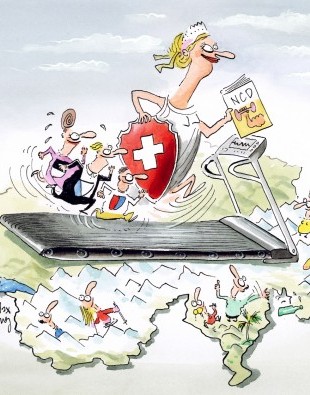
Looking back, looking ahead: The National Programme on Diet and Physical Activity
Avr. 2017End of the National Prevention Programmes
National Programme on Diet and Physical Activity (NPDPA 2008–2016). Enjoying life has a lot to do with nutrition and physical activity, because people who eat a balanced diet and get plenty of physical activity are providing a solid basis for their health, and feel good at the same time. The NPDPA was aimed at encouraging the Swiss population to live a healthy and more enjoyable lifestyle, and at providing conditions that would make this possible. A great deal has been achieved, and useful approaches will be continued and developed further with the new strategy on non-communicable diseases (NCDs).
Most people know that a healthy diet and sufficient physical activity are important. But there are still too many of us who disregard this. There are many complex reasons for their behaviour, but we can all find out how to look after our health for as long as possible and act accordingly. This would help to prevent NCDs. This development is not unique to Switzerland. The World Health Organisation adopted a 'Global Strategy on Diet, Physical Activity and Health' in 2004, and a 'European Charter on Counteracting Obesity' in 2006. This makes it clear that obesity has become more widespread as a result of socio-economic and cultural changes, and that measures are needed to curb its increase. Switzerland has supported these policy papers, and on 18 June 2008 the Federal Council commissioned the Federal Office of Public Health (FOPH) to develop and implement the 'National Programme on Diet and Physical Activity' in conjunction with its partners.
Partners in the NPDPA
Organisations that participated in the programme included the FOPH, which was responsible for programme management, the Federal Office of Sports (FOSPO), the Health Promotion Switzerland foundation (HPS) and the Swiss Conference of Cantonal Ministers of Public Health (GDK). These were joined by the Federal Food Safety and Veterinary Office (FSVO) on its establishment in 2014. In addition to the FOPH, FOSPO, HPS and FSVO, other federal agencies as well as industry and NGOs launched activities that contributed to achieving the objectives of the programme. Examples are the Federal Office for Spatial Development (ARE) with its innovative approaches to the integration of physical activity promotion into spatial planning, and the Federal Roads Office (FEDRO) with its promotion of active mobility with safe and attractive cycling and walking paths.
Objectives and activities of the programme Cross-sector coordination and the communication of positive messages, such as 'Enjoy what you eat' and 'Feel well with physical activity' , were some of the main issues of the programme. This should encourage to take more responsibility for one's own health, and persuade business and industry to undertake voluntary measures.
The results of an evaluation shortly before the programme ended in 2016 were positive:
Programme Management (FOPH / FSVO / FOSPO / HPS / GDK): The strategic management group of the programme met regularly to share information, and held preliminary discussions on the strategy that will follow (NCD strategy). The allocation of responsibilities is now clear.
Environmental setting (FOPH / FOSPO): the supported projects contribute to increased availability of options for physical activity due to the structural promotion of physical activity, removal of obstacles to physical activity and improved safety for active mobility. Specifically, the FOPH has provided annual support to an innovative project on active mobility via the 'Office for Sustainable Mobility' (KOMO, formerly the Service Centre for Innovative and Sustainable Mobility). The FOPH was also involved in the further development of the KOMO, and developed a guideline on Open Space Development together with other federal offices. Thanks to the 'Pilot Projects for Sustainable Spatial Development' , open spaces for physical activities will be developed in agglomerations throughout Switzerland.
Workplace setting (FOPH / HPS): Successful activities for promoting physical activity in the workplace include the 'Nestmove' pilot project, launched jointly at Nestlé by the SUVA (Swiss Accident Insurance Fund) and HPS. A further offer for organisations that addresses physical activity, ergonomics, nutrition and stress arose from a collaboration between the SUVA, HPS and the FOPH. The Migros supermarket chain is implementing this offer as a pilot project in the canton of Vaud.
Medical setting (FOPH): One objective of the new NCD strategy is to strengthen 'Prevention in Healthcare' . This objective will be achieved with the 'Girasole' pilot project. A key factor here is physical activity.
Monitoring and data collection (FOPH / FSVO / FOSPO / HPS): An important strategic instrument for preventive measures was created with the Diet and Physical Activity Monitoring System (MOSEB; www. moseb.ch). This provides information on the dietary and physical activity characteristics of the population in Switzerland based on 58 indicators.
Information, policy (FOPH / FSVO / FOSPO): Numerous measures have been taken to keep the public and relevant experts informed: a website, regular newsletters on current issues and pointed comments on the sedentary lifestyle (together with the FOSPO), as well as updating and disseminating recommendations regarding physical activity on the 'hepa.ch' network. The 'Swiss nutrition platform' (ERPLA) was used to exchange information on diet and nutrition. The introduction of topics related to nutrition and physical activity into the policies of other sectors and at the international level was promoted by departmental consultations that promoted collaboration on various strategies, concepts, multisector programmes and committees. At the International level, the FOPH also funded and co-organised a meeting of experts from the WHO on development of a strategy for physical exercise, and worked collaboratively on this strategy. The FSVO took over the chairmanship of WHO Europe's 'European Salt Action Network' (ESAN) and coordinated international exchange and capacity building.
Collaboration with industry (FOPH / FSVO): The FSVO took over activities related to nutrition in 2014. The 'actionsanté' initiative of the FOPH and the FSVO encouraged industry to change the situation of nutrition and physical activity by voluntary commitment, in order to make it easier for the Swiss population to make healthy choices. In the context of actionsanté's promises to become active, the salt strategy resulted in reductions of salt content by up to ten percent in four food groups of the partners. A reduction of the salt content in bread was achieved together with the Bakers Association, even without action promises. According to the Declaration of Milan, in August 2015 ten Swiss companies committed to revising their recipes for yoghurt and breakfast cereals and reducing their sugar content during the next four years.
Activities of the Federal Office of Sport (FOSPO): According to the number of participants in sports events arranged for children, youth and adults, the objectives were surpassed. The feedback from partners and other observations show a steady or increasing demand for sporting events or programmes in adults, and a general increase in sports activities.
Activities of Health Promotion Switzerland (HPS) and the cantons: The activities of the NPDPA are related to the cantonal nutrition and physical activity action programmes. Greater numbers of children and adolescents were reached, and there were also multiplier effects. Twenty cantons, covering about 90 percent of the population in Switzerland, committed their ongoing financial support. The number of planned measures has almost doubled since 2011, and one third of these have been implemented.
Finally, it should be noted that more adults engaged in sufficient physical activity from 2002–2012. A slight decrease in the number of overweight children and adolescents was observed.
Review and prospects for programme partners
The programme partners are satisfied with the achievements. For example, the MOSEB system now makes valuable basic data available to all partners. Joint activities related to promotion of physical activity at the workplace (FOPH, HPS, SUVA) and actionsanté (FOPH, FSVO) have again created synergies. Regular sharing of information between the partners identified duplication of effort at an early stage, and the programme has generally contributed to an improved definition of roles. The NPDPA has enabled the FOPH to position itself clearly with regard to environmental issues, and has revealed new approaches to the topics of nutrition and physical activity in the medical setting.
The NCD strategy covers all aspects of the NPDPA from 2017 onwards. The programme partners intend to continue with activities that have already proven to be successful.
BAG-Highlights des Nationalen Programms Ernährung und Bewegung (NPEB)
Sechs Höhepunkte der vergangenen acht Jahre zeigen, wie umfassend das Bundesamt für Gesundheit (BAG) mit dem Nationalen Programm Ernährung und Bewegung (NPEB) Massnahmen für einen gesunden Lebensstil zur Vorbeugung nichtübertragbarer Krankheiten vorangetrieben hat.
Monitoring-System Ernährung und Bewegung (MOSEB)
Mit dem MOSEB haben das BAG und seine Partner eine umfangreiche Sammlung repräsentativer Daten zur Ernährungs- und Bewegungssituation in der Schweiz aufgebaut. Es bildet eine wichtige Grundlage für die Planung und Umsetzung von Präventionsmassnahmen. Per Ende 2016 ist das MOSEB beendet worden. Es dient nun als Basis für das neue Monitoring-System NCD, das die Umsetzung der Nationalen Strategie Prävention nichtübertragbarer Krankheiten (NCD-Strategie) begleitet.
Bewegungsstrategie der WHO Europa
2015 hat die WHO der Region Europa mit Unterstützung des BAG die Europäische Strategie Bewegung für Gesundheit entwickelt. Es ist die erste Bewegungsstrategie der WHO überhaupt. Ziel ist, die Inaktivität unter der europäischen Bevölkerung bis 2025 um 10 Prozent zu reduzieren. Dies soll unter anderem durch Bewegungsförderung bei Kindern, Jugendlichen, Erwachsenen und Senioren sowie am Arbeitsplatz, aber auch durch ein bewegungsfreundliches Umfeld (strukturelle Bewegungsförderung) erreicht werden. In der Schweiz werden viele der geforderten Massnahmen in den fünf vorrangigen Handlungsfeldern bereits umgesetzt.
Modellvorhaben Nachhaltige Raumentwicklung 2014–2018
Mit den Modellvorhaben unterstützt der Bund Projekte von Akteuren, die neue Ansätze für die Umsetzung einer nachhaltigen Raumentwicklung erproben. Angestrebt wird u.a. eine Verbesserung der Lebensqualität (inkl. Gesundheit) durch schweizweit bewegungsfördernde Freiräume in den Agglomerationen und eine Vernetzung der Naherholungsgebiete durch den Langsamverkehr. Am Programm beteiligt sind neben dem federführenden Bundesamt für Raumentwicklung (ARE) und dem BAG sechs weitere Bundesämter. Es fokussiert auf die sektorenübergreifende Zusammenarbeit.
Koordinationsstelle für nachhaltige Mobilität (KOMO)
KOMO ist die zentrale Anlaufstelle des Bundes zu Fragen der nachhaltigen Mobilität. Sie unterstützt innovative Mobilitätsprojekte. Zudem ermöglicht sie als Wissensplattform den Austausch unter Akteuren. Seit 2016 hat das Bundesamt für Energie (BFE) die Leitung von KOMO, welche die Funktion und Aufgabengebiete des Dienstleistungszentrums für innovative und nachhaltige Mobilität (DZM) übernommen hat. Getragen wird sie vom BAG und von fünf weiteren UVEK-Ämtern.
Betriebliche Gesundheitsförderung
Der im Januar 2016 unterzeichnete Vertrag zwischen BAG, SUVA und Gesundheitsförderung Schweiz bekräftigt eine Zusammenarbeit, die bereits 2012 im Rahmen des NPEB begonnen hat. Kompetenzen und Ressourcen werden gebündelt, um den Unternehmen, die sich für die Gesundheit ihrer Mitarbeiterinnen und Mitarbeiter engagieren möchten, eine einheitliche Methodik und einheitliche Werkzeuge anbieten zu können. Insbesondere werden Ansätze entwickelt, die die wichtigsten vier Bereiche – Bewegung, ausgewogene Ernährung, Ergonomie und psychische Gesundheit – gleichzeitig angehen.
Girasole
Seit Oktober 2016 rekrutiert der Kanton Tessin die ersten Patientinnen und Patienten im Rahmen des Pilotprojekts Girasole. Dieses Pilotprojekt, das vom BAG zwei Jahre lang unterstützt wird, soll die Risikofaktoren für nichtübertragbare Krankheiten bei erwachsenen Patientinnen und Patienten reduzieren, die ihren Hausarzt oder ihre Hausärztin aufsuchen. Bewegung gilt dabei als Schlüsselfaktor. Im Mittelpunkt dieser Intervention steht die motivierende Gesprächsführung.
Contact
Contact:
Gisèle Jungo, Health Promotion and
Prevention Section,
gisele.jungo@bag.admin.ch







